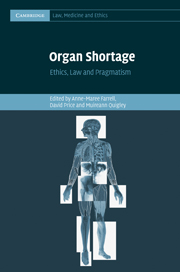Book contents
- Frontmatter
- Contents
- List of figures
- List of tables
- Contributors
- Acknowledgements
- List of abbreviations
- Table of cases
- Table of legislation
- Part I Setting the scene
- Part II Current issues affecting organ shortage
- Part III Strategies for addressing organ shortage
- Part IV Comparative perspectives
- 10 Institutional organisation and transplanting the ‘Spanish Model’
- 11 Kidney donation: lessons from the Nordic countries
- 12 Organ donation and transplantation: the Canadian experience
- 13 Systematic increases in organ donation: the United States experience
- Part V Current reform and future challenges
- Bibliography
- Index
- References
10 - Institutional organisation and transplanting the ‘Spanish Model’
from Part IV - Comparative perspectives
Published online by Cambridge University Press: 29 March 2011
- Frontmatter
- Contents
- List of figures
- List of tables
- Contributors
- Acknowledgements
- List of abbreviations
- Table of cases
- Table of legislation
- Part I Setting the scene
- Part II Current issues affecting organ shortage
- Part III Strategies for addressing organ shortage
- Part IV Comparative perspectives
- 10 Institutional organisation and transplanting the ‘Spanish Model’
- 11 Kidney donation: lessons from the Nordic countries
- 12 Organ donation and transplantation: the Canadian experience
- 13 Systematic increases in organ donation: the United States experience
- Part V Current reform and future challenges
- Bibliography
- Index
- References
Summary
In the debate over how to address organ shortage, one of the suggestions that has been made is that presumed consent legislation would help to increase the number of organ donations. Since Spain has the highest rate of deceased organ donation in the world (34.4 organ donors per million population (pmp) in 2009), it may be easy to assume that it is a direct consequence of its presumed consent legislation. It would be easy, but misleading. On the one hand, if presumed consent legislation held the key to organ procurement success, then all countries with similar legislation would be among the countries with the highest rates of organ donation and this is clearly not the case. On the other hand, this assumption fails to take into account any of the factors that make the Spanish system so successful.
Spanish legislation which introduced presumed consent for deceased organ donation dates back to 1979. However the rate of deceased organ donation only started to rise after the Spanish National Transplant Organisation (Organización Nacional de Trasplantes) (ONT) was created in 1989. From an average rate of organ donation in Spain at 14.3 donors pmp in 1989, it rose to having the highest world rate in 1993 with 22.6 donors pmp, reaching 35.1 donors pmp in 2005. Key features of the ONT which contributed to this success include a national network of specifically trained, part-time, dedicated and strongly motivated hospital physicians in direct charge of the whole process of donation.
- Type
- Chapter
- Information
- Organ ShortageEthics, Law and Pragmatism, pp. 151 - 170Publisher: Cambridge University PressPrint publication year: 2011
References
- 3
- Cited by



